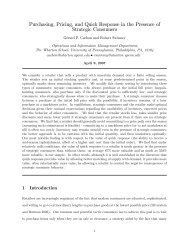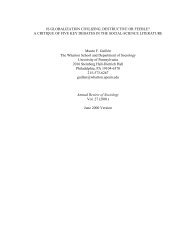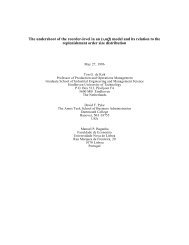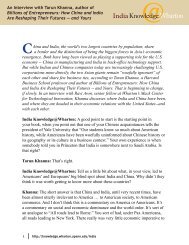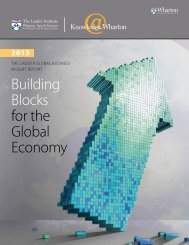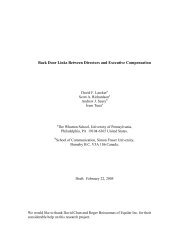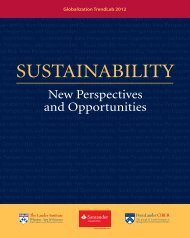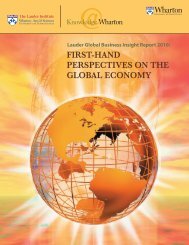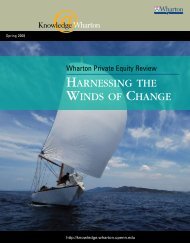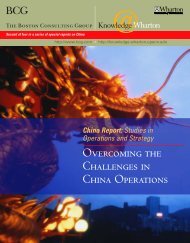The Lauder Global Business Insight Report 2011 - Knowledge ...
The Lauder Global Business Insight Report 2011 - Knowledge ...
The Lauder Global Business Insight Report 2011 - Knowledge ...
Create successful ePaper yourself
Turn your PDF publications into a flip-book with our unique Google optimized e-Paper software.
of ecological materials, equipment and practices; (b)<br />
improving the quality of life for society by creating a<br />
social fabric that fosters prosperous societies, as opposed<br />
to simply building commuter cities with little to no<br />
interaction among inhabitants, and (c) increasing access<br />
to financing for those in need while promoting savings<br />
through the efficient use of water and energy.<br />
Through public-private-sector partnerships and<br />
attractive incentives, the sustainable housing initiative<br />
innovatively addresses several of Mexico’s problems,<br />
namely, the massive housing deficit, the marginalization<br />
of low-income families, a lack of social integration,<br />
and growing environmental concerns. To this end,<br />
the Mexican government, along with private-sector<br />
firms, have instituted sustainable housing-development<br />
initiatives as a means to ensure the country’s economic,<br />
social and environmental viability.<br />
An Innovative public sector<br />
When President Felipe Calderón took office in late<br />
2006, his administration proactively began to address<br />
deficiencies in the housing market. In response to<br />
this new mandate, in early 2007, the federal housing<br />
commission, CONAVI, initiated the National Housing<br />
Program — an aggressive plan to construct six million<br />
homes by 2012, roughly one million of which are to<br />
be sustainable. <strong>The</strong> government soon elevated the<br />
program to legal stature and developed a multi-pronged<br />
execution strategy targeting several issues, such as<br />
access to financing, options for low-income residents<br />
and the availability of “green” (i.e., environmentally<br />
friendly) housing.<br />
To promote economic and social sustainability, the<br />
National Housing Program has put forth objectives to<br />
expand financing coverage for low-income families and<br />
marginalized groups, such as indigenous populations,<br />
single mothers and senior citizens. For example, in<br />
2007, CONAVI launched Ésta es tu Casa (“This Is Your<br />
Home”), a program to provide subsidies worth 20%-25%<br />
of the acquisition costs of homes for families earning<br />
up to four times the minimum wage (74,000 pesos or<br />
roughly US$6,000 per annum). To help fast-track such<br />
initiatives, the government granted contracts, credits<br />
and favorable financing terms to private developers<br />
constructing green or low-income homes.<br />
36 <strong>Knowledge</strong>@wharton • <strong>Lauder</strong> <strong>Global</strong> <strong>Business</strong> <strong>Insight</strong> <strong>Report</strong> <strong>2011</strong><br />
In addition, CONAVI also partnered with INFONAVIT<br />
(the National Workers Housing Institute) to ensure the<br />
provision of approximately 500,000 mortgages per year,<br />
including funding for low-income families. To reach<br />
the lowest-income populations, organizations such as<br />
FONHAPO (the National Peoples Housing Trust) and<br />
SEDESOL (the Secretariat for Social Development)<br />
provide mortgages to those without credit histories,<br />
to seasonal or temporary workers and to those<br />
participating in Mexico’s large informal economy.<br />
<strong>The</strong> Mexican government and CONAVI have made<br />
environmental sustainability another clear priority.<br />
CONAVI’s National Housing Program includes the<br />
regulation and standardization of green-housing<br />
modifications and norms to maintain high-quality,<br />
environmentally sustainable housing options. It also<br />
promotes green mortgages and subsidies, and has led<br />
to the launch of pilot training programs to educate the<br />
population on the benefits and operation of sustainable<br />
homes.<br />
To standardize and promote green housing development,<br />
CONAVI developed the Paquete Básico (“Basic<br />
Package”), a set of environmentally sustainable criteria<br />
that address site and terrain viability, water and waste<br />
management, and energy usage and insulation. CONAVI<br />
offered families purchasing homes that complied with<br />
the Paquete Básico an additional subsidy of 20%, in<br />
addition to the potential 20%-25% from the Ésta es tu<br />
Casa program. In 2008, CONAVI further expanded<br />
its commitment to environmental sustainability by<br />
modifying the subsidy program to make the Paquete<br />
Básico a requirement of all homes eligible for a single<br />
subsidy of 20%.<br />
In addition to subsidy programs for homeowners,<br />
INFONAVIT has committed to offering green mortgages<br />
to some low-income families. <strong>The</strong>se mortgages contain (a)<br />
higher up-front costs to acquire green modifications and<br />
(b) a payment plan that takes into account the long-term<br />
utility savings, allowing low-income families to purchase<br />
green homes that have larger capital requirements.<br />
With this government initiative in place, Mexico<br />
needed the participation of the private sector to boost<br />
the supply of sustainable housing options. CONAVI, in<br />
conjunction with several other organizations, instituted



